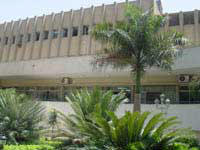| Fineart Sector |
|||

Prompted by its strong belief in the importance of art as a basic component of a nation's culture, the Sector of Fine Arts unleashes its artistic and cultural activities to give rise to the artist's inspirational sources of creativity in art movement. As a result, the artist can fully be integrated into society. Further, to widen the process of creativity the Sector of Fine Arts makes cultural sites available across the country to push forward the wheel of cultural development. Throughout its history, the Sector of Fine Arts has witnessed several development phases. It first acted as a Supervision of Fine Arts, a department affiliate to the Ministry of Maaref (education). When the Ministry of Culture was established in 1958 it supervised fine arts by opening the General Department of Fine Arts under the chairmanship of artist Salah Taher. In 1966 the General Administration of Museums, established in 1959, was annexed to the General Department of Fine Arts under the chairmanship of artist Abdel-Qader Rezk, who was the chief of art museums. Upon his retirement in 1972 Mr. Abdel-Hamid Hamdy was appointed the chief of the General Administration of Fine Arts and Museums. Hamdy successfully supervised plans, which turned the General Administration of Fine Arts and Museums into the General Authority of Arts and Culture. The latter included the Art Academy and both the Department of Arts Administrations of Arts and Sabbatical. By the establishment of the Supreme Council of Culture in 1980 the General Authority of Arts and Culture was replaced by the National Center of Fine Arts, which was chaired by artist Dr. Mustafa Abdel-Mo'ety. In 1988 Prof. Dr. Ahmed Nawar was appointed the Head of the National Center of Fine Arts, which was upgraded on February 16 th , 2000 , into the Sector of Fine Arts. Under Prof. Nawar, the Sector of Fine Arts has unveiled a dynamic and ambitious program to develop and upgrade art museums and cultural centers sponsored by the Sector. |
|||
| The Sector's Ambitions in Cultural Life | |||
| The Sector of Fine Arts sponsors a panoramic view of cultural and artistic activities by organising regular exhibitions. Artists representing different generations are encouraged to intensify their participation in major exhibitions (solo or group) at home and abroad, such as: | |||
| International Exhibitions | |||
| They stimulate interaction with foreign cultures and create a platform for the international dialogue of civilizations. Accomplishment of these aims appears in Alexandria International Biennale for the Mediterranean Countries, Cairo International Biennale, Egyptian International Print Triennale and Aswan International Sculpture Symposium. These international events give ample opportunity to artists from world countries to exhibit their works in Egypt . In the meantime, such activities help upgrade the organizational experiences of Egyptian staff members. Art lovers and critics are also given a good opportunity to enlarge their optical memory and widen their interaction with different cultures. | |||
| National Exhibitions | |||
| Their aims are conducted through two mechanisms, the first of which brings artists under a common umbrella of group exhibitions planned to cast much light on the latest creative works of art. The second mechanism is represented by solo exhibitions in which artists display tier individual experiments. The group exhibitions include the Youth Salon, the National Art Exhibition, the Salon of Mini Works of Art, Exhibition of Arabic Calligraphy, the Nile Salon for Photography, the Exhibition of Creativity of Egyptian Woman, Jewelry Exhibition and Sculpture Exhibition. | |||
| Overseas Exhibitions | |||
| Without basking in its international fame as the birthplace of Pharoanic civilisation and art, Egypt is always keen to intensify its participation in overseas exhibitions, whether solo or group, etc. to stress the creative aspects of its modern art. These intense participation are also wisely planned to draw the world's attention to the flowing river of creativity and its potentials to renew its sources. It is widely-known that Egypt's fine art alone stepped into the international limelight in the early 20 th century when Egyptian artists Mahmoud Mukhtar, Ahmed Sabry and successive generations displayed their works in private pavilions opened in major museums abroad. Today's generation made a tremendous success overseas when four young artists won the grand prix in Venice Biennale. | |||
| The Principal Bank of Art Information Technology | |||
| Taking into account the fact that breakthroughs in IT revolution should prompt efforts to make the best use of them, The Sector of Fine Arts established its Principal Bank of Art Information Technology. Described as a big leap the well-equipped Bank run by qualified and efficient staff largely contributes to documenting and chronicling art movement in Egypt . The Bank employs a variety of multi-media to safely record and chronicle its invaluable database. As a result, decision-makers, scholars and art students are given a convenient environment to satisfy their curiosity. The Bank's Internet updates international and national activities sponsored by the Sector. The Bank has already released a big number of CDs recording important events associated with art museums, exhibitions and biographies of artists | |||